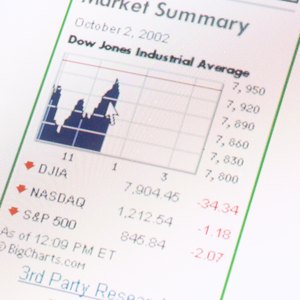
The Dow Jones Industrial Average is a market index that tracks the stocks of 30 large U.S. companies. These major companies with a long history of wide public interest are sometimes known as “blue chip” companies. Investors track the value of “the Dow” as an indicator of the overall health of the economy, but the Dow is only one such market index. In fact, it is one of the narrowest measures of the market as a whole. Another popular stock index is the Standard and Poor’s 500, which tracks the daily stock performance of 500 companies of various size.
History
Charles Dow, one-time editor of the Wall Street Journal and the founder of the Dow Jones Company, compiled the original Dow Jones Industrial Average with statistician Edward Jones. Dow and Jones intended the index to track the growth or contraction of U.S. industry. Their original 11 companies in 1884 grew to 30 by 1928 and represented major industries in the United States. Today, though the number of stocks in the Dow remains at 30, the companies represented range from large retailers to financial services companies to computer manufacturers.
Value of the Dow
The Dow Jones Industrial Average is not a true average. Instead, the value of the Dow is computed by adding up the value for which the stocks for each of the 30 companies in the index is trading and dividing by a divisor. The editors of the Wall Street Journal first used the divisor in 1928. The divisor is designed to account for stock splits and other price adjustments, and therefore to keep the value of the index consistent. The value of the divisor changes whenever a stock splits or pays a dividend.
What the Numbers Mean
When news reports announce that the Dow has fallen by so many points, they mean the total value of the stocks in the Dow, divided by the divisor, has decreased. This doesn’t mean that the value of all 30 stocks, or even most of the 30 stocks, has fallen. A sharp decline in only a few stocks can result in a falling Dow. Other stocks within the Dow and stocks not included in the Dow may have risen.
The Dow as an Economic Indicator
News reports focus on the performance of the Dow as a reflection of the overall stock market. Originally the Dow was conceived as an economic indicator for one segment of the U.S. economy: industry. While the Dow tracks some of the largest U.S. companies, such as WalMart and Coca-Cola, it follows only 30 stocks out of the approximately 2,800 traded on the New York Stock Exchange. Volatility and heavy trading of only a few stocks can affect the value of the Dow, which provides only one picture of stock activity and should be compared with other indexes, such as the S&P 500.
References
- U.S. Securities and Exchange Commission: Market Indices
- Swarthmore University: Dow Jones Industrial Average
- Stanford University: The Dow Jones Industrial Average – The Impact of Fixing Its Flaws
- ADVFN: New York Stock Exchange – Company Listings
- S&P Dow Jones Indices. "Dow Jones Averages Methodology," Pages 3 & 5. Downloaded from "Dow Jones Industrial Average®," Select "Methodology." Accessed May 30, 2020.
- Zacks. "Stock Market Points Vs. Percent." Accessed May 30, 2020.
- S&P Dow Jones Indices. "Dow Jones Averages Methodology," Page 3. Downloaded from "Dow Jones Industrial Average®," Select "Methodology." Accessed May 30, 2020.
- S&P Dow Jones Indices. "Dow Jones Averages Methodology," Page 11. Downloaded from "Dow Jones Industrial Average®," Select "Methodology." Accessed May 30, 2020.
- The Library of Congress. "Dow Jones Industrial Average First Published." Accessed May 30, 2020.
- Valeriy Zakamulin. "Market Timing with Moving Averages: The Anatomy and Performance of Trading Rules," Page 224. Springer, 2017.
- Geoffrey Poitras. "Valuation of Equity Securities: History, Theory and Application," Page 161. World Scientific, 2010.
- Independent Stock Review "History of the Dow Jones Industrials Index 1884 - 2002." Accessed May 30, 2020.
- Bloomberg. "NDU:IND," Accessed May 30, 2020.
- S&P Dow Jones Indices. "The Evolution of the Dow." Accessed May 30, 2020.
- Cision PR Newswire. "Walgreens Boots Alliance Set to Join Dow Jones Industrial Average." Accessed May 30, 2020.
- Zacks. "How Many Stocks Are in Dow Jones Industrial Average?" Accessed My 30, 2020.
- Morningstar. "Calculating the Dow." Accessed May 30, 2020.
- Global Financial Data. "The Complete Dow Jones Industrial Average." Accessed May 30, 2020.
- S&P Dow Jones Indices. "Dow Jones Averages Methodology," Page 7. Downloaded from "Dow Jones Industrial Average®," Select "Methodology." Accessed May 30, 2020.
- Wilshire. "Wilshire 5000 Family : Wilshire 5000 Total Market Index." Accessed May 30, 2020.
- S&P Dow Jones Indices. "S&P U.S. Indices Methodology," Page 3. Accessed May 30, 2020.
- CNBC. "An indicator with a nearly perfect track record is predicting a stock market pullback." Accessed May 30, 2020.
Writer Bio
Cynthia Myers is the author of numerous novels and her nonfiction work has appeared in publications ranging from "Historic Traveler" to "Texas Highways" to "Medical Practice Management." She has a degree in economics from Sam Houston State University.

